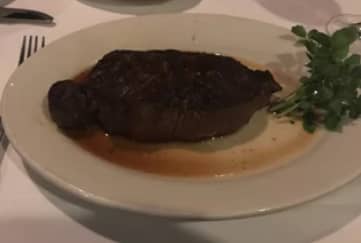CLEO:2017 Tomohiro Tetsumoto
Research
CLEO:2017 Participation Report
Ph.D.3Tomohiro Tetsumoto, senior
Outline
I attended CLEO:2017 held from May 14 to 19, which is the largest international conference in our industry, and the overall quality of the presentations was high. Although this was the first time for me to attend the conference, I attended many interesting lectures and had a fulfilling time. On the other hand, there were some poster presentations that were thrown together and some oral presentations that lasted only 4 minutes, so I could confirm that not all the presentations were excellent. I have included a photo of a steak from Morton's, which was the only American-like meal at the conference (Fig. 1).

2. regarding his/her presentation
I gave a poster presentation on TE/TM mode coupling in silica nanobeam resonators. The presentation lasted for two hours, but there were not many people in the second half of the presentation, probably because it was during lunch time. In total, I talked with less than 10 people, and was generally asked to give a rough explanation of the basics of the topic. I was able to respond to most of the questions without any confusion, but I regret that I could not respond immediately to a person who strongly insisted that Q-value could not be measured without a dip of 3 dB or more, and I had to ask for help from the audience present. I realized that it is better to be prepared to think and explain in English even about general matters that are not details of research. I was encouraged that people in the field of photonic crystals were more interested in the localization of TE and TM modes with the same resonance wavelength than I expected.
3. topic introduction
FM4G.6: Integrated zero-index waveguides
The Loncar group at Harvard presented a simple waveguide structure on an SOI wafer with an effective refractive index of zero. The design guideline seems to be to make the electric field dipole mode and magnetic field quadrupole mode degenerate at the Γ point so that the D and B modes cancel each other in the neighboring lattice. I also found the method of measuring the effective refractive index interesting. Since the structure of this research is a waveguide, it is difficult to measure the effective refractive index from the reflection or refractive angle as in previous research. Therefore, we measured the effective refractive indices by observing the interference fringes created in the structure by inputting light of the same wavelength into the waveguide at the same wavelength by an IR camera. The interference fringe interval was λ/2neffThe interference fringes appear to have a single belly when the effective refractive index is 0, since the value is given by In this study, it was experimentally confirmed that the effective refractive index is zero at 1630 nm. In the questioning, the effect of reflection due to impedance mismatch was pointed out, and the answer was not quite clear, but according to the reference paper, both the effective dielectric constant and magnetic permeability are zero, so that the impedance has a finite value. Rather, it seems that the structure is aimed at solving the problem of impedance mismatch of integrated materials with zero effective refractive index.
FTh4D.5: Temporal Dissipative Solitons in a Microresonator Driven by Optical Pulses
Presentation by Dr. Herr of CSEM. CW light is usually used for microcomb generation, but if pulsed light can be used for excitation, there are advantages in terms of generation efficiency and suppression of thermal effects. In this study, pulsed light input to a Fabry-Perot resonator with an FSR of 9.77 GHz was used to realize microcomb generation. One feature of this system is that the repetition frequency of the generated comb can be controlled by adjusting the repetition frequency of the input pulses, independent of the FSR of the resonator. However, if pulses are used as seeds, it might be better to use a mode-locked microcomb without using a micro resonator. As Mr. Herr is a former member of the Kippernberg group and knows the industry well, we should pay attention to his research trends. In other words, he may be working on his research from a slightly different perspective because he is familiar with the trends of other groups. I attended many other com-related presentations at this CLEO, and I felt that our laboratory still has a gap with the top group, and I wondered if we could catch up with them by a straightforward approach.
- Categories
- 国際会議報告


